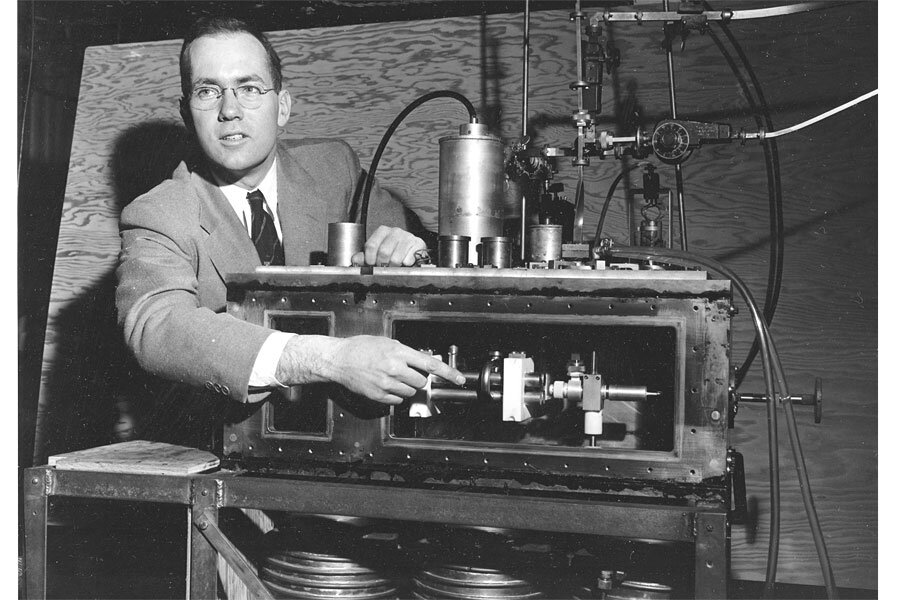Laser pioneer Charles H. Townes sought to fuse science with religion
Loading...
| Berkeley, Calif.
Charles H. Townes' inspiration for the predecessor of the laser came to him while sitting on a park bench, waiting for a restaurant to open for breakfast.
On the tranquil morning of April 26, 1951, Townes scribbled a theory on scrap paper that would lead to the laser, the invention he's known for and which transformed everyday life and led to other scientific discoveries.
Townes, who was also known for his strong spiritual faith, famously compared that moment to a religious revelation.
The Nobel Prize-winning physicist died Tuesday.
In 1954, that theory was realized when Townes and his students developed the laser's predecessor, the maser (microwave amplification by stimulated emission of radiation).
"I realized there would be many applications for the laser," Townes told Esquire magazine in 2001, "but it never occurred to me we'd get such power from it."
The laser paved the way for other scientific discoveries that revolutionize everything from medicine to manufacturing, but also has a huge array of applications today: DVD players, gun sights, printers, computer networks, metal cutters, tattoo removal and vision correction are just some of the tools and technologies that rely on lasers.
"Charlie Townes had an enormous impact on physics and society in general," Steven Boggs, the chairman of the physics department at Berkeley, said Wednesday.
A devoted member of the United Church of Christ,Townes drew praise and skepticism later in his career with a series of speeches and essays investigating the similarities between science and religion.
"Science tries to understand what our universe is like and how it works, including us humans,"Townes wrote in 2005 upon being awarded the Templeton Prize for his contributions in "affirming life's spiritual dimension."
"My own view is that, while science and religion may seem different, they have many similarities, and should interact and enlighten each other," he wrote.
Townes was a faculty member at Columbia University when he did most of the work that would make him one of three scientists to share the 1964 Nobel Prize in physics for research leading to the creation of the laser. The others were Russian physicists Aleksandr M. Prokhorov and Nicolai G. Basov.
Townes' research applied the microwave technique used in wartime radar research to the study of spectroscopy, the dispersion of an object's light into its component colors.
He envisioned that would provide a new window into the structure of atoms and molecules and a new basis for controlling electromagnetic waves. His insights eventually led to the first laser.
Born on July 28, 1915, in Greenville, S.C., to Baptist parents who embraced an open-minded interpretation of theology, Townes found his calling during his sophomore year at Furman University and went on to earn a master's degree from Duke University in physics and a doctorate at the California Institute of Technology.
He married his wife, Frances Hildreth Townes, in 1941, and during World War II designed radar bombing systems for Bell Laboratories.
Demonstrating that masers could be made to operate in optical and infrared capacities, Townes and his brother-in-law, the late Stanford professor Arthur L. Schawlow, jointly published a theory in 1958 on the feasibility of optical and infrared masers, or lasers.
A laser controls the way that energized atoms release photons, or light particles. Today, they perform tasks ranging from cutting metal to vision correction and tattoo removal, but its inventors say they didn't foresee any of that.
Others built the first working lasers, but Townes shared the Nobel Prize in 1964 with the two Russians for his work leading to its creation.
"I feel that very rarely have I done any work in my life," he told Esquire. "I have a good time. I'm exploring. I'm playing a game, solving puzzles, and having fun, and for some reason people have been willing to pay me for it. Officially, I was supposed to retire years ago, but retire from what? Why stop having a good time?"
In 1966, he published an article entitled "The Convergence of Science and Religion" in the IBM journal THINK.
The difference between science and religion "are largely superficial," he wrote, "the two become almost indistinguishable if we look at the real nature of each."
In an era when many scientists steadfastly avoided ties to religion, the views expressed in the piece were seen as blasphemy by people in both communities. Over the years, he wrote and spoke often on the subject, and in 2005, he won the Templeton Prize for Progress Toward Research or Discoveries about Spiritual Realities.
The award, billed as the world's richest religion prize, was worth more than $1.5 million, and past recipients have included Mother Teresa.
"Many people don't realize that science basically involves assumptions and faith. But nothing is absolutely proved," Townes said at the time. "Wonderful things in both science and religion come from our efforts based on observations, thoughtful assumptions, faith and logic."
Townes lived in Berkeley and is survived by his wife and four daughters, Linda Rosenwein, Ellen Townes-Anderson, Carla Kessler, and Holly Townes.
Copyright 2015 The Associated Press. All rights reserved. This material may not be published, broadcast, rewritten or redistributed.







